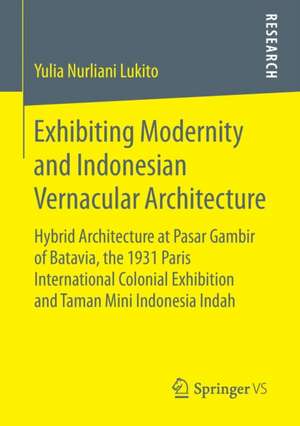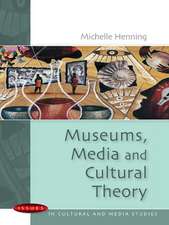Exhibiting Modernity and Indonesian Vernacular Architecture: Hybrid Architecture at Pasar Gambir of Batavia, the 1931 Paris International Colonial Exhibition and Taman Mini Indonesia Indah
Autor Yulia Nurliani Lukitoen Limba Engleză Paperback – 29 oct 2015
Preț: 382.36 lei
Nou
Puncte Express: 574
Preț estimativ în valută:
73.19€ • 79.52$ • 61.52£
73.19€ • 79.52$ • 61.52£
Carte tipărită la comandă
Livrare economică 21 aprilie-05 mai
Preluare comenzi: 021 569.72.76
Specificații
ISBN-13: 9783658116040
ISBN-10: 3658116048
Pagini: 192
Ilustrații: XV, 192 p. 52 illus.
Dimensiuni: 148 x 210 x 12 mm
Greutate: 0.28 kg
Ediția:1st ed. 2016
Editura: Springer Fachmedien Wiesbaden
Colecția Springer VS
Locul publicării:Wiesbaden, Germany
ISBN-10: 3658116048
Pagini: 192
Ilustrații: XV, 192 p. 52 illus.
Dimensiuni: 148 x 210 x 12 mm
Greutate: 0.28 kg
Ediția:1st ed. 2016
Editura: Springer Fachmedien Wiesbaden
Colecția Springer VS
Locul publicării:Wiesbaden, Germany
Cuprins
Pasar Gambir of Batavia: Hybrid Architecture and Space of Encounter for the Indies People.- The Dutch Pavilion at the 1931 International Colonial Exhibition in Paris: Contrasting Authenticity and Modernity.- Taman Mini Indonesia Indah: the Rebirth of Indonesian Vernacular Architecture after Independence.
Notă biografică
Yulia Nurliani Lukito received her doctorate degree in Theory of Architecture from RWTH Aachen. Her research interests are theory and history of architecture, modernity, and Indonesian vernacular architecture.
Textul de pe ultima copertă
In her research Yulia Nurliani Lukito analyses modernity and the construction of culture by the authorities using the images of Indonesian vernacular architecture presented at three different sites and times. She argues that modernity is not solely constructed by the authorities, rather it is an ongoing process modified by visitors of exhibitions. Pasar Gambir was a laboratory of modernity for the colony, and an important stage in modernizing and negotiating cultural and social conditions in the colony. The Dutch Pavilion at the 1931 colonial exhibition became a moment when the Indies heritages played a role in marking colonial territory. Modern ethnographic park of Taman Mini gives a way to the making of an official ‘authentic’ culture and suppresses the previous Dutch construction of the Indies culture.
Contents
· Pasar Gambir of Batavia: Hybrid Architecture and Space of Encounter for the Indies People · The Dutch Pavilion at the 1931 International Colonial Exhibition in Paris: Contrasting Authenticity and Modernity
· Taman Mini Indonesia Indah: the Rebirth of Indonesian Vernacular Architecture after Independence
Target Groups
· Lecturers and students of the social sciences especially in history and theory of architecture · Readers who are interested in cultural studies, architecture, history, and modernity
The Author
Yulia Nurliani Lukito received her doctorate degree in Theory of Architecture from RWTH Aachen. Her research interests are theory and history of architecture, modernity, and Indonesian vernacular architecture.
Contents
· Pasar Gambir of Batavia: Hybrid Architecture and Space of Encounter for the Indies People · The Dutch Pavilion at the 1931 International Colonial Exhibition in Paris: Contrasting Authenticity and Modernity
· Taman Mini Indonesia Indah: the Rebirth of Indonesian Vernacular Architecture after Independence
Target Groups
· Lecturers and students of the social sciences especially in history and theory of architecture · Readers who are interested in cultural studies, architecture, history, and modernity
The Author
Yulia Nurliani Lukito received her doctorate degree in Theory of Architecture from RWTH Aachen. Her research interests are theory and history of architecture, modernity, and Indonesian vernacular architecture.
Caracteristici
Includes supplementary material: sn.pub/extras











